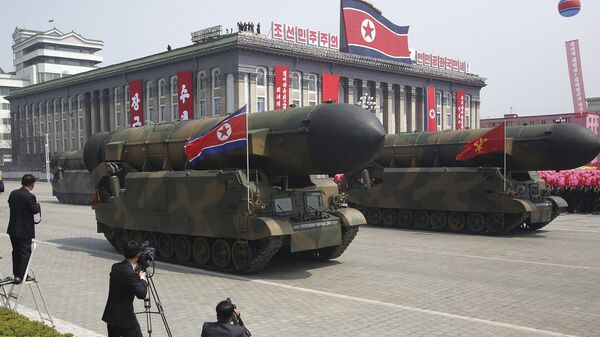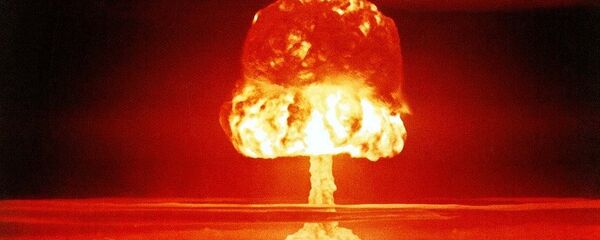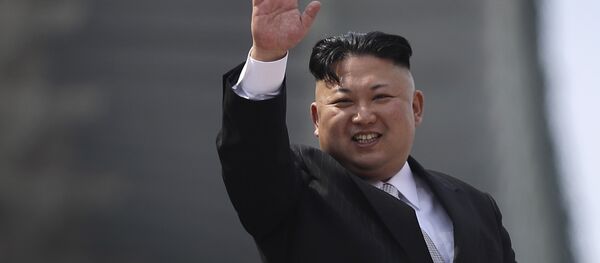Formally known as the Day of the Sun, it is the most important national holiday in North Korea, often used to display the country's military capabilities. This year, the DPRK has used Kim Il-sung's 105th birth anniversary to showcase new types of intercontinental ballistic missiles (ICBM) at a large-scale military parade held annually at Pyongyang's Kim Il Sung Square.
The path of escalation
The war of words between the United States and North Korea escalated after Pyongyang stepped up its military efforts, carrying out a series of missile tests and pledging to conduct its sixth nuclear test. As a result, Washington officially ended its policy of "strategic patience" toward the reclusive nation, saying that all options are on the table.
On April 9, US National Security Advisor H.R. McMaster said that President Trump asked his team to provide "a full range of options to remove" the threat posed by North Korea. He also accused Pyongyang of being "engaged in a pattern of provocative behavior," calling it a "rogue" and "nuclear capable regime."
Washington's strike potential
"'The full range of options' which we have seen earlier in the Middle East makes it possible for the Korean War to reignite in the near future," journalist Alexander Khrolenko wrote for Sputnik, referring to the Pentagon's operation against Damascus.
The United States has military assets to carry out an operation against North Korea if it chooses to, including the Seventh Fleet headquartered in Yokosuka, Japan, as well as land-based and aerial forces deployed to Japan and South Korea (nearly 70,000 US service personnel).
In addition, Boeing B-52 Stratofortress, Rockwell B-1 Lancer and B-2 Northrop Grumman B-2 Spirit strategic bombers stationed at an airbase in the United States territory of Guam could also be used for such an operation.
"The United States is capable of launching massive airstrikes and carrying out amphibious operations without deploying additional forces to the region," Khrolenko said. "The Pentagon has also considered bringing back nuclear bombs to South Korea, which were transferred to the US 25 years ago, tacking out the North Korean leader, deploying special operations forces to the DPRK and carrying out sabotage attacks on nuclear facilities."
North Korea's capabilities
Pyongyang has invested heavily into advancing its military capabilities and is quite capable of defending itself. The Korean People's Army is estimated to be 1 million people strong, twice the size of the Republic of Korea Armed Forces.
Most importantly, Pyongyang has continued to develop ballistic missiles and nuclear weapons.
In March, North Korea launched four ballistic missiles deployed to the Tongchang-ri region into the Sea of Japan. The missiles are said to have covered a distance of approximately 1,000 kilometers (620 miles), with three landing as close as 300 kilometers (190 miles) from Japan's coast.
Last year, Pyongyang tested a submarine-launched ballistic missile near the coastal city of Sinpo. The missile is said to have covered a distance of approximately 500 kilometers toward Japan, but its maximum range is estimated to have been approximately 1,000 kilometers.
"Even if North Korean missiles are currently flying less than 1,000 kilometers, the launch from a submarine allows Pyongyang to respond to even a remotely located state. A submarine is capable of reaching a distance optimal for a missile attack on any of US military bases in Japan. It could even reach US shores," Khrolenko explained, adding that the DPRK has focused on developing sea-based missiles.
The analyst expressed doubt that North Korea will "capitulate" under outside pressure or agree to a formula used for the German reunification. Instead Pyongyang is more likely to continue developing weapons systems, he said.
"If the United States wages reckless provocation against us, our revolutionary power will instantly counter with annihilating strike, and we will respond to full-out war with full-out war and to nuclear war with our style of nuclear strike warfare," Choe Ryong Hae, a senior North Korean official, said during the parade.
These remarks echoed those made earlier by a spokesman for the General Staff of the Korean People's Army, who said that any US activities that Pyongyang views as provocations would "thoroughly be foiled through the toughest counteraction of the army and people of the DPRK."
Never miss a story again — sign up to our Telegram channel and we'll keep you up to speed!




